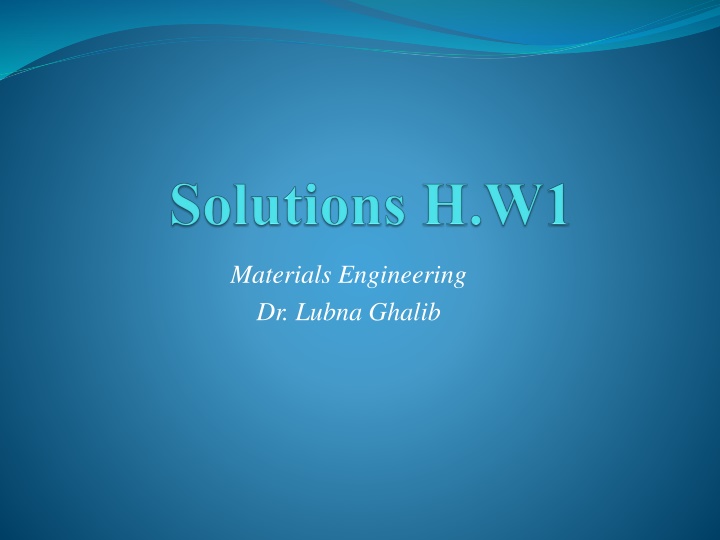
Electrochemistry Exercises: Calculate Oxygen Electrode Potential, Reverse Polarity, and pH Determination
Explore electrochemistry exercises including calculating oxygen electrode potential at pH 14, reversing polarity in a cell reaction, and determining pH in a zinc-hydrogen cell. Dive into the world of materials engineering with Dr. Lubna Ghalib's guidance and solve challenging problems related to electrode reactions and cell potentials.
Download Presentation

Please find below an Image/Link to download the presentation.
The content on the website is provided AS IS for your information and personal use only. It may not be sold, licensed, or shared on other websites without obtaining consent from the author. If you encounter any issues during the download, it is possible that the publisher has removed the file from their server.
You are allowed to download the files provided on this website for personal or commercial use, subject to the condition that they are used lawfully. All files are the property of their respective owners.
The content on the website is provided AS IS for your information and personal use only. It may not be sold, licensed, or shared on other websites without obtaining consent from the author.
E N D
Presentation Transcript
Materials Engineering Dr. Lubna Ghalib
Exercise 1: Calculate the potential of oxygen electrode at pH=14.0. Solution : Oxygen electrode reaction: in basic and neutral environment is expressed as: O2 + 2H2O + 4e- 4(OH- ) Electrode potential equation for the electrode basic solution), and at 25 oC. ? = ?? ?? ??ln ? = 0.401 0.0591 4 ??? = 1 4 ?? log?(?? )= 0 Eo= + 0.401 V ????????? ?????????? 4 ?(?? ??2? ) l?? 2 ??2
Exercise 1: O2 + 2H2O + 4e- 4(OH- ) Eo= + 0.401 V 4 ?(?? ??2? (0.0)(?? ) ? = 0.401 0.0591 l?? 2 4 ??2 4 ) ? = 0.401 0.0591 l?? 4 1 E= 0.401 V
Exercise 2: In the cell reaction given below, what is the ratio of the activities of ionic species required to make the polarity reverse? Fe2+ + Sn Sn2+ + Fe Solution: Fe2+ + 2e- Fe Sn Sn2+ + 2e- Final Cell reaction Fe2+ + Sn Eocell= (-0.440+0.136)= - 0.304 V Eo= -0.440 V Eo= +0.136 V Sn2+ + Fe The reaction in this case is non-spontaneous. That is, Fe2+/Fe electrode will act as 'anode' and Sn2+/Sn electrode will act as 'cathode,' the reverse case of what was assumed in the problem. To reverse the polarity:
Exercise 2: Solution: To reverse the polarity: ????????? ?????????? ?Sn2+?Fe ?Sn?Fe2+ ? = ?? ?? ??ln ? = 0.304 0.0591 l?? 2 Ecell = 0, At the turn of polarity. Therefore, 0.304 = 0.0591 ?Sn2+ ?Fe2+ l?? 2 ?Sn2+ ?Fe2+= 5.156 10 11
Exercise 3: The emf of a cell made of Zn (anode) and H2 electrode (cathode) immersed in 0.7 M ZnCl2 is +0.690 volts. What is the pH of the solution? Activity coefficient ?=0.6133. ????2 ??2++ 2?? 0.7M 0.7M 0.7M Zn2+ + 2e- Zn 2H+ + 2e- H2 ?=0.6133 Eo= - 0.763 V Eo= 0.0 V Zn2+ + 2e- Zn2+ + H2 Eo= +0.763 V Eo= 0.0 V Eo =+0.763 V Anode: Cathode: Final: Zn + 2H+ Zn 2H+ + 2e- H2
Exercise 3: ????????? ?????????? ? = ?? ?? ??ln +0.690 = +0.763 0.0591 ?Zn2+?H2 ?Zn ?2 (0.7 0.6133 ?2 l?? 2 H+ +0.690 = +0.763 0.0591 l?? 2 H+ 0.073 = 0.0591 (0.42931 ?2 l?? 2 H+ 2.4703 = l?? 0.42931 ??? ?2 2.8376 = 2?? H+ pH= 1.4187
Exercise 4: Calculate the theoretical tendency of nickel to corrode in deaerated water of pH = 8. Assume the corrosion products are H2 and Ni (OH)2 and the solubility product is 1.6x 10-16? Solution: Ni2+ + 2e- Ni 2H+ + 2e- H2 Anode: Ni Ni2+ + 2e- Cathode: 2H+ + 2e- Final: Ni + 2H+ Ni2+ + H2 pH + pOH = 14 pOH = 14- 8 = 6 [OH-] = 10 6 [H+] = 10 8 Eo= - 0.25 V Eo= 0.0 V Eo= +0.25V Eo= 0.0 V Eo =+0.25 V H2
Exercise 4: Ni2+OH 2 ?? ??2 Ni2+10 6 2 ???= 1.6 10 16= 1 Ni2+=1.6 10 4 ????????? ?????????? ?Ni2+?H2 ?Ni ?2 ? = ?? ?? ??ln ? = 0.25 0.0591 l?? 2 H+ 1.6 10 4 [10 8]2 ? = 0.25 0.0591 l?? 2 E= - 0.11063 V
Exercise 5: Calculate the pressure of H2 required to stop corrosion of iron immersed in 0.1 M FeCl2and =0.58, pH = 4. Solution: Fe 2+ + 2e- Fe 2H+ + 2e- H2 Anode: Fe Fe2+ + 2e- Cathode: 2H+ + 2e- Final: Fe + 2H+ Fei2+ + H2 Eo= - 0.440 V Eo= 0.0 V Eo= +0.440 V Eo= 0.0 Eo =+0.440 V H2 V ????2 ??2++ 2?? 0.1 M 0.1 M 2(0.1 M) ?=0.75 ????????? ?????????? ? = ?? ?? ??ln
Exercise 5: ? = 0.44 0.0591 ?Fe2+?H2 ??? ?2 l?? 2 H+ ??2 ?? ??= 1 ???., standard state Ecell =0.0 V 0.0 = 0.44 0.0591 ??2= stop corrosion 0.1 0.75 ??2 [10 4]2 l?? 2 ??2 = 103503648 atm. ??2= 10+8 ???
Exercise 6: Calculate if silver would corrode when immersed in 0.5 M CuCl2 and =0.42 to form solid AgCl. What is the corrosion tendency? Solution : 2AgCl + 2e- 2Ag + 2Cl- Cu 2+ + 2e- Cu Anode: 2Ag + 2Cl- Cathode: Cu 2+ + 2e- Final: 2Ag +Cu 2+ + 2Cl- ????2 ??2++ 2?? 0.5 M 0.5 M 2(0.5 M) ? = ?? ?? ??ln Eo= + 0.222 V Eo= + 0.34 V Eo= - 0.222 V Eo= + 0.34 V 2AgCl + 2e- Cu 2AgCl + Cu Eo =+0.118 V ?=0.47 ????????? ??????????
Exercise 6: ?2 AgCl?Cu ? = 0.118 0.0591 l?? ?2?????2+?2?? 2 ? = 0.118 0.0591 1 l?? 0.5 0.472 2 0.5 0.472 2 E= 0.061451 V silver will corrode






















